Growing up in Scotland: early experiences of primary school
This research report highlights the key findings from the Growing up in Scotland early experiences study.
CHAPTER 3 SCHOOL CHOICE, SCHOOL CHARACTERISTICS AND MOVING SCHOOLS
3.1 Introduction
This chapter examines several issues around school choice including:
- the factors that parents considered important when deciding which primary school the cohort child should attend,
- what proportion of parents made placing requests for a non-designated school and the extent to which such requests were successful,
- sources of information and advice on enrolment and satisfaction with these,
- school characteristics, and
- changing schools.
It is important to understand the factors that parents consider when deciding which primary school their children should attend. Over the years, a number of studies have identified key reasons for parents choosing schools. It appears that academic performance, while important, is generally not the chief amongst these - for those whose children went to state schools, Hansen and Vignoles (2010), using Millennium Cohort Study data, found that proximity and attendance of siblings/friends preceded performance as major factors for school choice. This was true to a similar extent across all countries of the UK. Reviewing earlier studies of experiences at Scottish secondary school level, Willms (1997) notes that proximity again, and factors such as good discipline and a good social atmosphere were considered more important than academic performance.
The opportunity to actually exercise choice in schooling was established as a statutory right in the Education (Scotland) Act 1980. In contrast to the rest of the UK, children in Scotland are automatically allocated a place and enrolled in a designated local school, but parents may make a written request to place their child in another school - known as a placing request. Hansen and Vignoles (2010) found that, in 2005-06, 38% of Scottish parents made such a request. This is much lower than those making an application for a particular school in other countries of the UK and the authors suggest that this is related to the fact that "in rural areas the local school may be the only practical option" (p.191). Naturally, the literature overall also notes that choice may only be practical in towns and cities, and thus more parents in urban areas make placing requests than those in more rural areas.
Especially in the context of school choice, parents require good information about schools to help make informed choices. To this end, there are various sources of official guidance available such as the Parentzone area of Education Scotland website, and official advice includes suggestions such as visiting the school(s) and speaking to the headteacher 3 . However, previous reviews such as Willms (1997) noted that while parents said that official information was useful in making choices they actually relied heavily on knowledge gathered via social networks, especially other parents.
Another fundamental choice that parents may exercise, financial constraints allowing, is between state and private schooling. The numbers choosing private education at primary school level are lower than at secondary UK-wide, but differ by country. For the children in the Millennium Cohort Study, in Scotland the figure is around 2%, compared to 5% in England (Hansen and Vignoles, 2010). This may reflect the lower proportion of private schools in existence in Scotland (though clearly there is a relationship between this and demand) but also the differences in the variety of state schools in the respective countries. The Scottish state education system has less diversity in school type (no Academies or Free Schools) and delivery of the curriculum and in (perceived) performance between schools. These things will undoubtedly relate to the extent that school choice is exercised.
As well as issues of school choice, this chapter also provides a summary of the characteristics of the schools attended by children during the first school year. Finally, we shall briefly examine the extent to which children have changed schools during the Primary 1 year, and the reasons for this.
3.2 Key findings
- Proximity is the most common reason given as the main factor influencing choice of school: 34% of parents cited this reason.
- The importance attached to the school's exam results/academic reputation has a strongly positive relationship to parental social advantage across several indicators (area deprivation, socio-economic classification, equivalised income and highest level of parental qualification).
- 32% of parents made a placing request whilst the remainder (67%) accepted their allocated place at their local school. Only 1% of parents making a placing request were unsuccessful.
- Placing requests were more common amongst families in more disadvantaged circumstances.
- 61% of parents sought advice on enrolment ahead of their child starting school; pre-school and primary school staff were the most commonly cited sources. Satisfaction with the advice was very high, with 95% of parents saying they were quite or very satisfied.
- 19% of children were attending a faith school and 4% of children attended a school where some form of Gaelic Medium Education was being provided.
- Most children in Primary 1 (66%) attend schools with 200 or more pupils on the roll. Just 8% attend a school with less than 100 pupils.
- Children living in areas in the least deprived quintile and those living in areas classified as 'large urban' were more likely to attend larger schools than those living in all other area types.
- The average P1 intake was 39 pupils and an average P1 class included 19 pupils.
- Children living in less deprived areas are more likely than those living in areas with higher deprivation, to attend schools with larger Primary 1 intakes and larger Primary 1 class sizes.
3.3 Factors influencing school choice
Proximity (34%) is clearly the biggest factor by some margin (Figure 3-A) - even if other similar categories are combined such as the 'exam results/academic reputation' and 'general good impression of school' categories (24%) or the 'siblings went/go there' and 'friends go/intending to go there' (22%).
Figure 3‑ A Most important factor when thinking about schools the child might attend
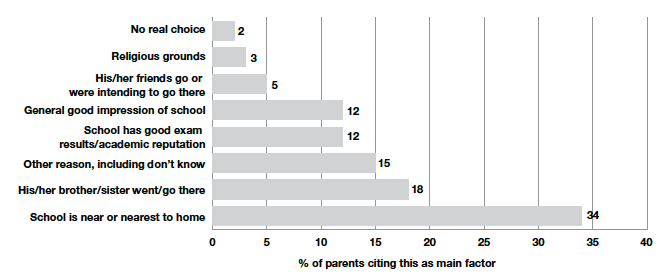
Bases: weighted: 3627; unweighted: 3644
There are large and striking differences in the importance attached to the school's exam results/academic reputation across a set of associated parental characteristics: area deprivation, socio-economic classification ( NS- SEC), equivalised household income and highest level of parental qualification. Across all of these characteristics, those in the 'higher' categories (least deprived area, managerial and professional occupations, highest income and highest level of qualification) cite the school's exam results/academic reputation as the most important factor much more frequently than those in the 'lower' categories. The contrasts are stark: twice the proportion of parents in the least deprived areas (18%) as in the most deprived (9%); just over twice in the highest income quintile (19%) as in the lowest (8%); over three times those in managerial and professional occupations (16%) compared with those who have never worked (5%) and four times the proportion of those parents with a degree or higher-level qualification (16%) compared with those with no qualifications (4%).
Looking at differences by urban/rural classification, it is not surprising that 'no real choice' is much more commonly cited by those living in remote rural areas (14%) than all other types of area (between 1% and 3% for the middle four urban/rural categories) - and is not a factor at all for those in large urban areas. The importance of proximity also maps closely with increasing rurality as shown in Figure 3‑B, though a slightly lower proportion of those living in remote rural areas (43%) cited this factor than those in accessible rural areas (45%).
Figure 3‑ B Percentage of parents citing proximity and 'no real choice' as main factors for school choice by urban/rural classification
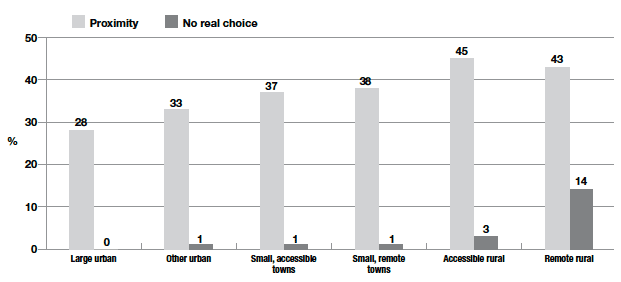
Bases: weighted: 3627; unweighted: 3631
Some other differences included:
- Proximity of the school was less important for older mothers than for younger mothers - 30% of mother's aged 40 or older (at the time of the interview) selected this factor compared with 38% of those aged between 20 and 29.
- As may be expected, in larger families, attendance of siblings at the school was more important than for smaller families.
- Parents with a white ethnic background tended to give less importance to the school's academic reputation compared with those of other ethnic backgrounds, but this difference was not statistically significant.
3.4 Placing requests
In Scotland, children are automatically allocated a place and enrolled in a designated local school, but parents may make a written request to place their child in another school - known as a placing request.
Around one-third (32%) of parents reported that they had requested a school place whilst the remainder (67%) said they had been allocated a place at their local school. Only 1% of parents making a placing request were unsuccessful - their child is not currently at the school they made the request for. This low number means it is not possible to analyse further the characteristics of parents not getting their school of choice.
Placing requests were more common amongst families in more disadvantaged circumstances suggesting that these families were less content with the quality of their catchment school. For example, 42% of parents living in an area in the most deprived quintile made a placing request compared with 29% of parents living in an area in the least deprived quintile (Figure 3‑C). Similar patterns were observed by household income. Those from an 'other ethnic background' were also more likely to make a request than those from a white background (45% compared to 32%). Parents living in rural and remote areas were less likely to make a placing request than those in urban areas, presumably because there is less choice (18% living in remote rural compared to 37% in large urban areas, with a positive relationship between likelihood of making a request and increasingly urban classification) - a factor reflected in the earlier data.
Figure 3‑ C Percentage of parents who made a placing request or accepted an allocated place, by area deprivation index
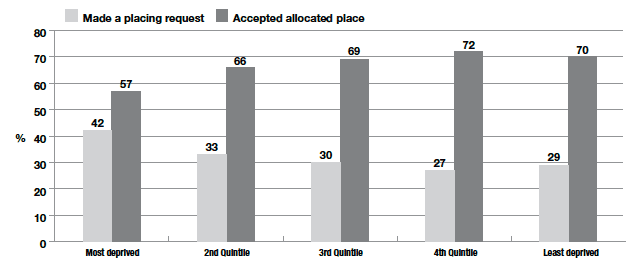
Bases: weighted: 3613; unweighted: 3612
There are some differences in the main reason for choosing a school between parents making or not making a placing request (Figure 3‑D). Proximity is the still the dominant factor overall, but unsurprisingly it is far more important for those allocated a place than those making a placing request (40% as to 20%). Also, as might be expected, the school's exam results/academic reputation is more important for those requesting a place - but the difference is not large (14% to 11%). 'Other' reasons are much more important to those making a request (24% to 11%) and the presence of siblings is cited as the main factor for 21% of those requesting a place compared with 16% of those allocated a place. Religious grounds appear to be important to the same degree irrespective of placing request or allocation.
Figure 3‑ D Percentage of parents citing different main factors when thinking about schools the child might attend, by whether made a placing request
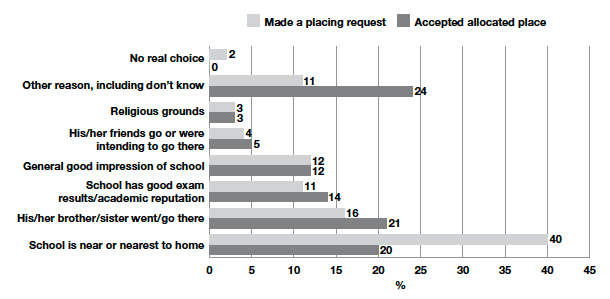
3.5 Sources of information and advice on enrolment 4
Sixty-one per cent of parents reported looking for advice ahead of the child starting school. All sources were used by at least some respondents, but the most frequently cited were pre-school (39%) and primary school staff (21%), and several informal sources including friends (29%), other parents (11%) or siblings (9%).
Overall, there appear to be very high levels of satisfaction with the level of advice, information and support available. Over 95% of parents were very or quite satisfied, and only 2% were quite or very dissatisfied.
There are few clear patterns in the characteristics of those parents who did or did not seek advice. The proportion seeking any advice decreases with increasing number of children and respondent age, as might be expected because they are more likely to already have children in school. There is some variation by parental education, but no clear pattern. There are no other significant differences.
There is previous evidence (Mabelis and Marryat, 2011) that at earlier child ages disadvantaged parents are less likely to seek information and advice from formal sources. This analysis examines the use of any formal source, and then the number of formal sources used. Formal sources are here defined to include primary school staff, pre-school staff, the Local Authority and the Parentzone website.
There are few statistically significant variations in use of any formal sources amongst parents with different characteristics. Parents with degree level qualifications are most likely to have used any formal source (57%) though it is those with middle qualifications (upper-level Standard Grades or intermediate vocational qualifications) that are least likely (42%). Those with no qualifications (45%), lower level Standard Grades or other qualifications (48%) and Higher Grades or upper level vocational qualifications (47%) use any formal source to a similar extent. Use of any formal source decreases with the number of children in the household - as with use of any source.
Use of any formal source also varies by urban/rural classification: those in large urban and remote rural areas are least likely to have used any formal source (45%), while those in small remote towns are most likely (64%).
The number of formal sources used by those who used any varied in two significant ways. First, by tenure. Parents with 'Other' tenure status were least likely to have used two or more sources (16%), followed by 'social rented' (26%), owner occupied (34%) and those in private rented accommodation - who were most likely to have used two or more sources (67%). Urban/rural classification was also related to the number of sources used. Those in remote and accessible rural areas were most likely to have used two or more (53% and 43% respectively); those in large urban, other urban and small remote towns were about equally likely (31-32%) and those in small accessible towns were least likely (26%) to have used two or more sources.
3.6 School characteristics
Primary school education is delivered via a variety of different school and classroom environments across Scotland. Schools vary in the number and age mix of pupils, denomination, the geography of their surrounding area and a myriad of other characteristics. All of these varying characteristics contribute to a child's school experience and may impact on that experience in different ways for different pupils. This section uses the administrative data held by ScotXed on the schools attended by children in Growing Up in Scotland to explore some of the key variations in school environment experienced by Scottish children when they enter primary school.
The administrative data analysed below is only routinely available for state-run schools. Data from the parent questionnaire indicates that just 1% of children were attending an independent school in Primary 1 5 . As such the administrative data describe the schools attended by the vast majority of children in GUS and in Scotland. No survey data are used in this section of the report.
3.6.1 Denomination and Gaelic language
Scottish state schools are, by and large, either non-denominational or Roman Catholic. A small number of other faith schools also operate catering for children of other Christian, Jewish or Muslim faiths. The data indicate that 19% of children were attending a faith school in their Primary 1 year. The vast majority of these children (90%) attend a Roman Catholic school (17% of all children in P1).
As noted in the introduction, following the Standards for Scottish Schools Act (2000), local authorities began to develop and enhance their education provision. On applying for a school place, parents in some local authorities can choose - via a placing request - to send their child to a school which offers Gaelic Medium Education ( GME). Figures indicate that in 2010-11 there were 2312 children in 60 primary schools across 14 local authorities receiving some form of GME ( HMIE, 2011).
In Primary 1, GUS data suggest that 4% of children were attending a school where some form of GME was being provided. At school level, the delivery of GME is defined, via the administrative data, in one of six ways:
- Exclusively taught through Gaelic
- All curriculum through Gaelic or bilingual
- Some curriculum through English, some through Gaelic
- Gaelic the only subject taught through Gaelic
- Gaelic taught as learner
- No Gaelic taught
Amongst those children who were attending a school which offered GME, 44% were in the 'Gaelic taught as learner' category, with a further 29% at schools teaching exclusively through Gaelic. The remainder were evenly split between the other categories (around 9% in each).
3.6.2 School, intake and class size
For the purposes of this analysis, school 'size' is defined in terms of number of pupils. Children in Scotland enter primary schools which range from having as few as 10 to over 300 pupils. The mean number of pupils across all primary schools was 261. As shown in Figure 3‑E, most children in Primary 1 (66%) attend schools with 200 or more pupils and just 8% attend a school with less than 100 pupils.
Figure 3‑ E Percentage of pupils attending primary school by total number of pupils
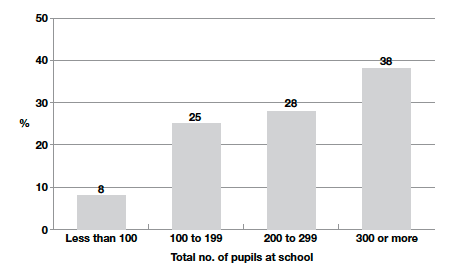
School size varied by the area deprivation and urban-rural classification of the child's home address 6 . Children living in areas in the least deprived quintile and those living in areas classified as 'large urban' were more likely to attend larger schools than those living in all other area types. For example, 63% of children living in the least deprived quintile attended a school with 300 or more pupils compared with between 31% and 35% of those living in more deprived areas. Half (50%) of children living in large urban areas attended schools with 300 or more pupils. Only a slightly smaller proportion did so in small, accessible towns (46%) and small, remote towns (47%). However, considerably fewer attended such large schools in accessible (14%) and remote rural areas (8%).
As may be expected, the size of the school was associated with both the size of the P1 intake and the average P1 class size. Children who started their school career at larger schools tended to do so alongside a greater number of pupils across the year group and in their class. The average P1 intake at the time GUS children started school was 39 pupils. This ranged from just 1 to over 100 pupils. As illustrated in Figure 3‑F, 40% of children were in a year group of between 20 and 39 pupils and 33% started as one of 40 to 59 pupils. Lower proportions joined the smallest year groups of less than 20 pupils and the largest year groups of 60 pupils or more (13% and 14% respectively).
On average, a P1 class included 19 pupils. This figure did vary to some extent. Around one-quarter (24%) of pupils started in a class of up to 15 pupils in total, with about a further quarter (27%) in a class of between 16 and 19 pupils. Twenty-nine per cent were in a class of between 20 and 23 pupils, and 21% shared a class with a total of 24 or more pupils.
Figure 3‑ F Percentage of pupils attending primary school by total number of pupils in corresponding P1 intake
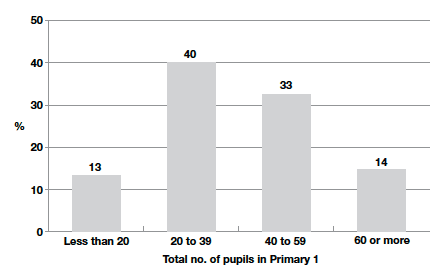
The patterns of school size seen by area deprivation and urban-rural classification illustrated above are repeated in relation to numbers of P1 pupils and class sizes (Table 3.1 and Table 3.2). Children living in less deprived areas are more likely than those living in areas with higher deprivation to attend schools with larger Primary 1 intakes and larger Primary 1 class sizes. School characteristics, in terms of pupil numbers, are broadly similar for pupils living in areas in the 2nd through 5th deprivation quintiles - it is only the figures for those living in the least deprived quintile which are notably different.
Table 3.1 Mean total number of pupils, pupils in P1, and P1 class sizes by area deprivation quintile
| Area deprivation (2009) | |||||
|---|---|---|---|---|---|
| Least deprived | 2 | 3 | 4 | Most deprived | |
| Mean total number of pupils | 338.1 | 241.1 | 236.9 | 247.0 | 247.9 |
| SE | 11.34 | 8.69 | 8.40 | 6.57 | 7.88 |
| Mean number of pupils in Primary 1 | 50.0 | 35.8 | 35.1 | 37.6 | 37.9 |
| SE | 1.63 | 1.36 | 1.31 | .99 | 1.18 |
| Mean Primary 1 class size | 20.9 | 18.7 | 17.5 | 18.8 | 19.0 |
| SE | 0.33 | 0.44 | 0.41 | 0.31 | 0.30 |
| Bases | |||||
| Weighted | 599 | 656 | 601 | 619 | 687 |
| Unweighted | 715 | 740 | 648 | 565 | 493 |
As shown in Table 3.2, children living in large urban areas experience the largest P1 intakes and average class sizes. However, the key distinction is between the four 'urban' and the two 'rural' categories. For children living in either remote or accessible rural areas, both P1 intake and class sizes are significantly smaller than for their urban peers.
Table 3.2 Mean total number of pupils, pupils in P1, and P1 class sizes by area urban-rural classification
| Urban-rural classification | ||||||
|---|---|---|---|---|---|---|
| Large urban | Other urban | Small, accessible towns | Small remote towns | Accessible rural | Remote rural | |
| Mean total number of pupils | 299.8 | 266.5 | 288.5 | 281.0 | 173.0 | 124.1 |
| SE | 8.66 | 6.85 | 13.25 | 23.28 | 8.55 | 9.37 |
| Mean number of pupils in Primary 1 | 45.2 | 40.1 | 42.7 | 40.4 | 25.9 | 17.8 |
| SE | 1.31 | 1.05 | 1.76 | 4.25 | 1.31 | 1.60 |
| Mean Primary 1 class size | 21.0 | 18.9 | 19.2 | 19.7 | 15.9 | 12.6 |
| SE | 0.28 | 0.24 | 0.45 | 1.03 | 0.44 | 1.18 |
| Bases | ||||||
| Weighted | 1119 | 1062 | 327 | 86 | 385 | 184 |
| Unweighted | 1025 | 1025 | 342 | 96 | 449 | 224 |
With considerably smaller school, intake and class sizes, it is unsurprising that children attending schools in rural areas had a greater chance of experiencing Primary 1 as part of a composite class with older children. Overall, 41% of children started in a school where at least one P1 class was a composite (though they may not have been in that class) 7 . In remote rural areas this figure rose to 65%, whereas in large urban areas it was 30%. Figures in the most and least deprived areas were similar at 36% and 38% respectively. However, the proportion was higher for children living in areas in the 2nd and 3rd deprivation quintiles at 45% and 48% respectively.
3.7 Changing schools
Just 1% of children had changed schools since starting P1. Of those who had, most had only attended one other school although a small number had attended two. The dominant reason by far for changing school was a house move - cited by 55% of those parents where the child had changed school. Twelve per cent said they had moved to a school nearer their home and 9% because of problems with the previous school.
Contact
There is a problem
Thanks for your feedback